check engine MITSUBISHI COLT 2008 (in English) Owner's Guide
[x] Cancel search | Manufacturer: MITSUBISHI, Model Year: 2008, Model line: COLT, Model: MITSUBISHI COLT 2008Pages: 450, PDF Size: 14.57 MB
Page 330 of 450
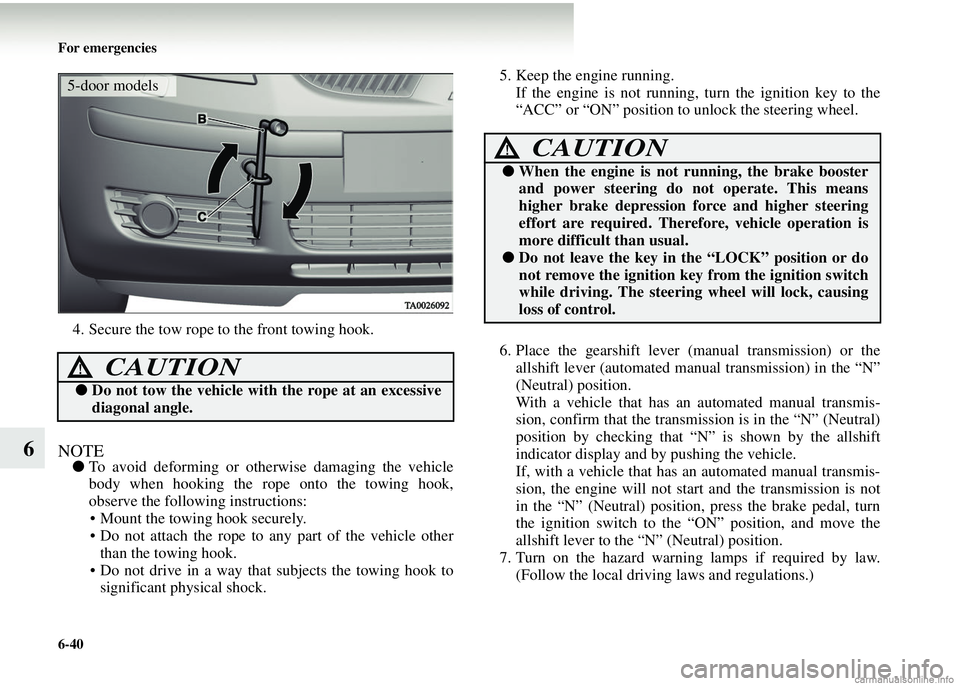
6-40 For emergencies
6
4. Secure the tow rope to the front towing hook.
NOTE●To avoid deforming or otherwise damaging the vehicle
body when hooking the rope onto the towing hook,
observe the following instructions:
• Mount the towing hook securely.
• Do not attach the rope to any part of the vehicle other
than the towing hook.
• Do not drive in a way that subjects the towing hook to significant physical shock. 5. Keep the engine running.
If the engine is not running, turn the ignition key to the
“ACC” or “ON” position to unlock the steering wheel.
6. Place the gearshift lever (m anual transmission) or the
allshift lever (automated manual transmission) in the “N”
(Neutral) position.
With a vehicle that has an automated manual transmis-
sion, confirm that the transmi ssion is in the “N” (Neutral)
position by checking that “N ” is shown by the allshift
indicator display and by pushing the vehicle.
If, with a vehicle that has an automated manual transmis-
sion, the engine will not start and the transmission is not
in the “N” (Neutral) position, press the brake pedal, turn
the ignition switch to the “ON” position, and move the
allshift lever to the “N” (Neutral) position.
7. Turn on the hazard warning lamps if required by law. (Follow the local driving laws and regulations.)
CAUTION!
● Do not tow the vehicle with the rope at an excessive
diagonal angle.
5-door models
CAUTION!
● When the engine is not running, the brake booster
and power steering do no t operate. This means
higher brake depression force and higher steering
effort are required. Therefore, vehicle operation is
more difficult than usual.
● Do not leave the key in the “LOCK” position or do
not remove the ignition key from the ignition switch
while driving. The steering wheel will lock, causing
loss of control.
Page 340 of 450
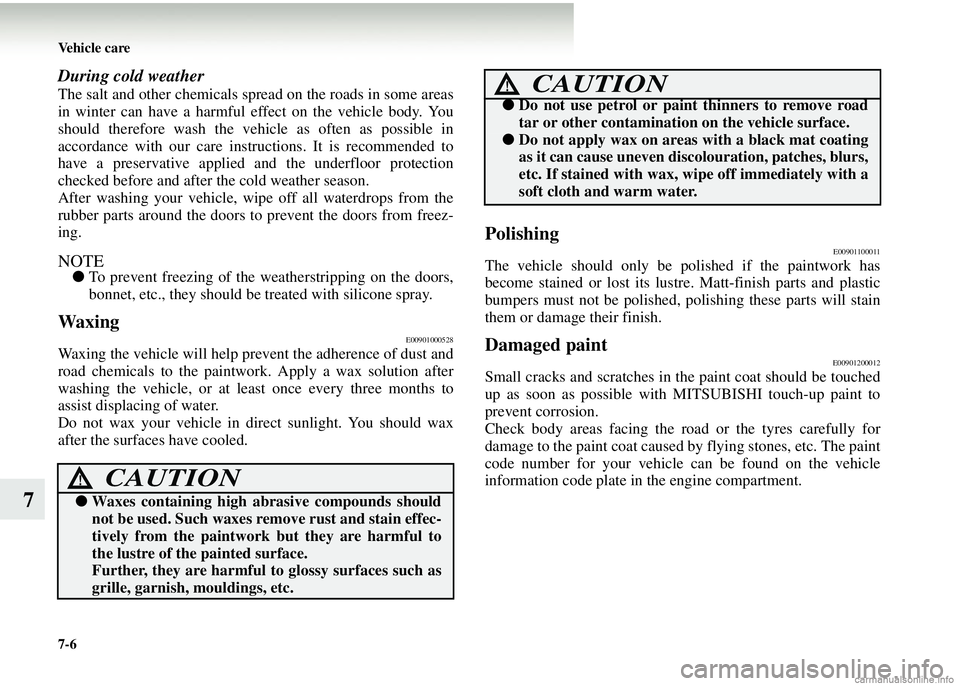
7-6 Vehicle care
7
During cold weather
The salt and other chemicals spread on the roads in some areas
in winter can have a harmful effect on the vehicle body. You
should therefore wash the ve hicle as often as possible in
accordance with our care instruc tions. It is recommended to
have a preservative applied an d the underfloor protection
checked before and after the cold weather season.
After washing your vehicle, wipe off all waterdrops from the
rubber parts around the doors to prevent the doors from freez-
ing.
NOTE● To prevent freezing of the w eatherstripping on the doors,
bonnet, etc., they should be treated with silicone spray.
WaxingE00901000528
Waxing the vehicle will help prev ent the adherence of dust and
road chemicals to the paintwor k. Apply a wax solution after
washing the vehicle, or at least once every three months to
assist displacing of water.
Do not wax your vehicle in direct sunlight. You should wax
after the surfaces have cooled.
PolishingE00901100011
The vehicle should only be polished if the paintwork has
become stained or lost its lustre. Matt-finish parts and plastic
bumpers must not be polished, polishing these parts will stain
them or damage their finish.
Damaged paintE00901200012
Small cracks and scratches in th e paint coat should be touched
up as soon as possible with MITSUBISHI touch-up paint to
prevent corrosion.
Check body areas facing the road or the tyres carefully for
damage to the paint coat caused by flying stones, etc. The paint
code number for your vehicle can be found on the vehicle
information code plate in the engine compartment.
CAUTION!
●Waxes containing high abrasive compounds should
not be used. Such waxes rem ove rust and stain effec-
tively from the paintwork but they are harmful to
the lustre of the painted surface.
Further, they are harmful to glossy surfaces such as
grille, garnish, mouldings, etc.
● Do not use petrol or paint thinners to remove road
tar or other contamination on the vehicle surface.
●Do not apply wax on areas with a black mat coating
as it can cause uneven disc olouration, patches, blurs,
etc. If stained with wax, wipe off immediately with a
soft cloth and warm water.
CAUTION!
Page 344 of 450
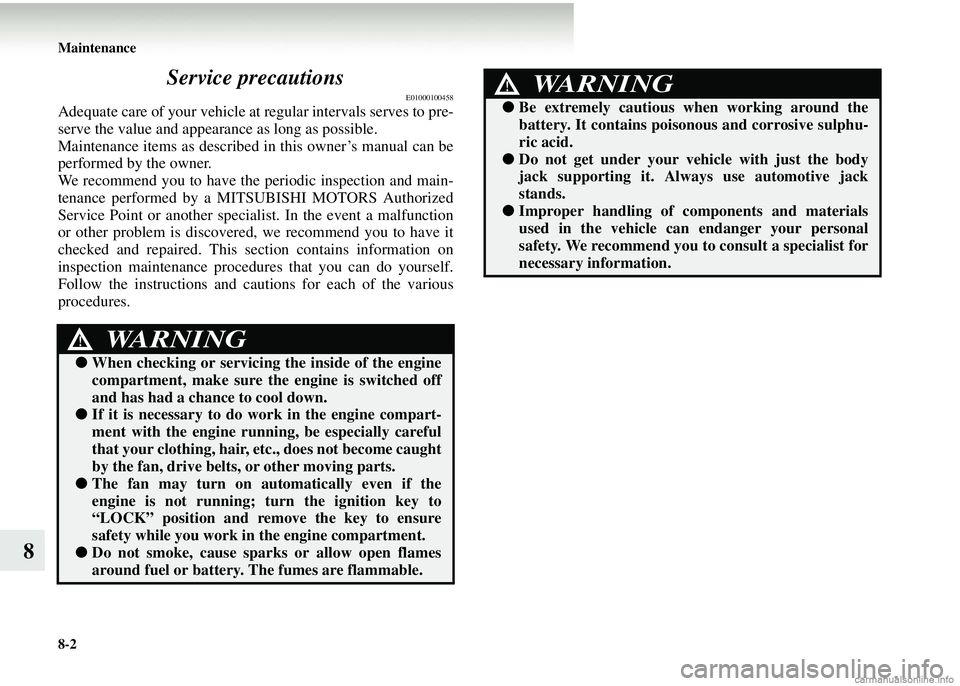
8-2 Maintenance
8Service precautions
E01000100458
Adequate care of your vehicle at
regular intervals serves to pre-
serve the value and appear ance as long as possible.
Maintenance items as described in this owner’s manual can be
performed by the owner.
We recommend you to have the periodic inspection and main-
tenance performed by a MITS UBISHI MOTORS Authorized
Service Point or another specialist. In the event a malfunction
or other problem is discovered, we recommend you to have it
checked and repaired. This section contains information on
inspection maintenance procedures that you can do yourself.
Follow the instructions and cautions for each of the various
procedures.
WARNING!
● When checking or servicing the inside of the engine
compartment, make sure th e engine is switched off
and has had a chan ce to cool down.
●If it is necessary to do work in the engine compart-
ment with the engine runni ng, be especially careful
that your clothing, hair, et c., does not become caught
by the fan, drive belts, or other moving parts.
● The fan may turn on automatically even if the
engine is not running; turn the ignition key to
“LOCK” position and remove the key to ensure
safety while you work in the engine compartment.
●Do not smoke, cause sparks or allow open flames
around fuel or battery. The fumes are flammable.
●Be extremely cautious wh en working around the
battery. It contains poison ous and corrosive sulphu-
ric acid.
● Do not get under your vehicle with just the body
jack supporting it. Always use automotive jack
stands.
●Improper handling of comp onents and materials
used in the vehicle can endanger your personal
safety. We recommend you to consult a specialist for
necessary information.
WARNING!
Page 349 of 450
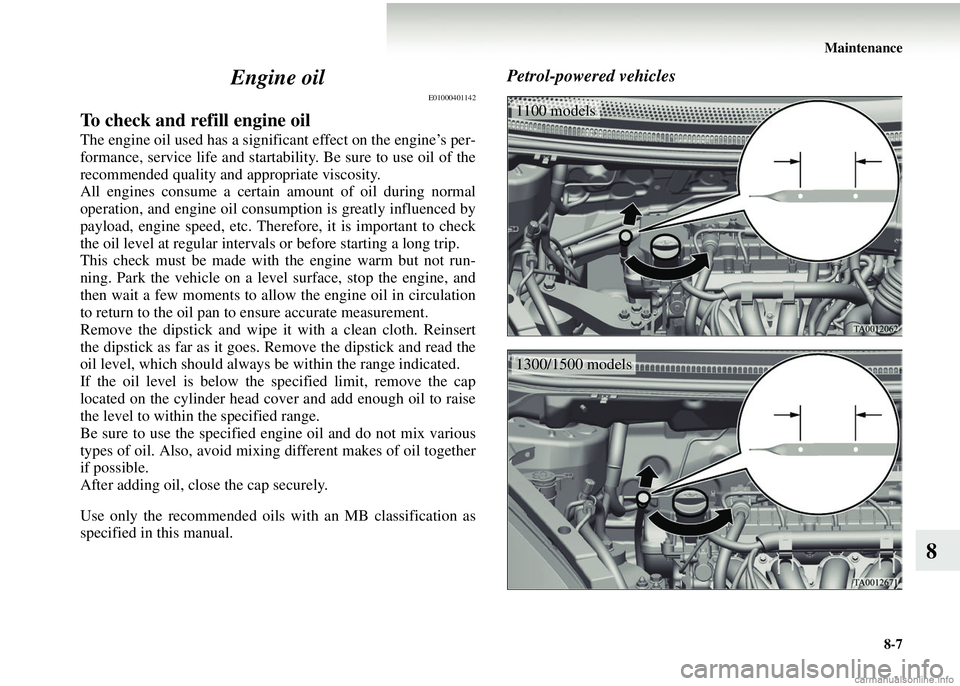
Maintenance8-7
8
Engine oil
E01000401142
To check and refill engine oil
The engine oil used has a significant effect on the engine’s per-
formance, service life and startability. Be sure to use oil of the
recommended quality and
appropriate viscosity.
All engines consume a certain amount of oil during normal
operation, and engine oil consumption is greatly influenced by
payload, engine speed, etc. Ther efore, it is important to check
the oil level at regular intervals or before starting a long trip.
This check must be made with the engine warm but not run-
ning. Park the vehicle on a level surface, stop the engine, and
then wait a few moments to allow the engine oil in circulation
to return to the oil pan to ensure accurate measurement.
Remove the dipstick and wipe it with a clean cloth. Reinsert
the dipstick as far as it goes. Remove the dipstick and read the
oil level, which should always be within the range indicated.
If the oil level is below the specified limit, remove the cap
located on the cylinder head cover and add enough oil to raise
the level to within the specified range.
Be sure to use the specified e ngine oil and do not mix various
types of oil. Also, avoid mixing different makes of oil together
if possible.
After adding oil, cl ose the cap securely.
Use only the recommended oils with an MB classification as
specified in this manual.
Petrol-powered vehicles
1100 models
1300/1500 models
Page 353 of 450
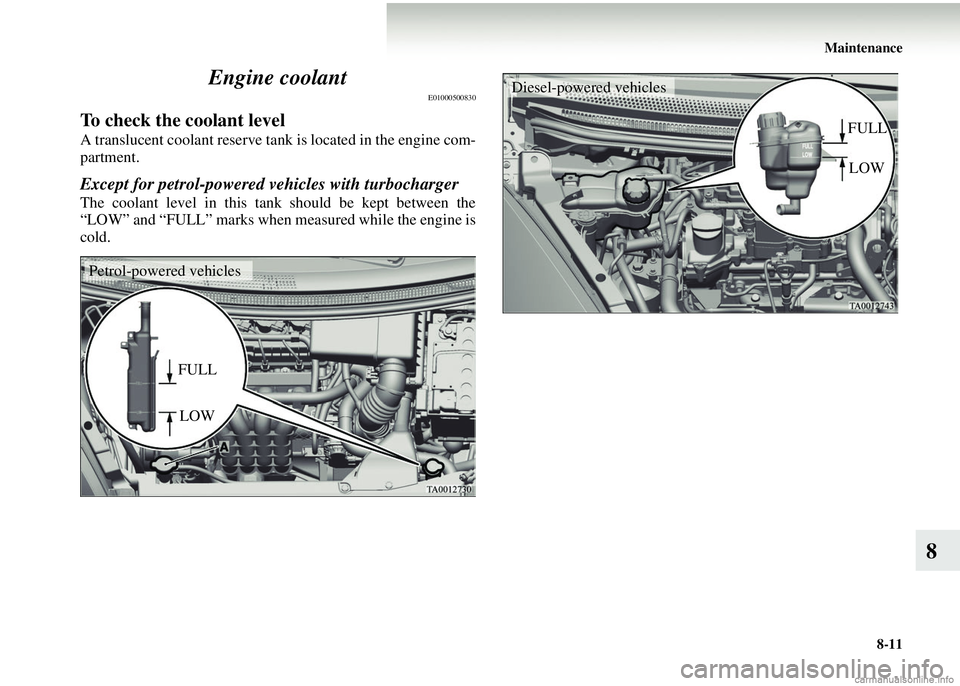
Maintenance8-11
8
Engine coolant
E01000500830
To check the coolant level
A translucent coolant reserve tank
is located in the engine com-
partment.
Except for petrol-powered vehicles with turbocharger
The coolant level in this tank should be kept between the
“LOW” and “FULL” marks when measured while the engine is
cold.
FULL
LOW
Petrol-powered vehicles
Diesel-powered vehicles
FULLLOW
Page 354 of 450
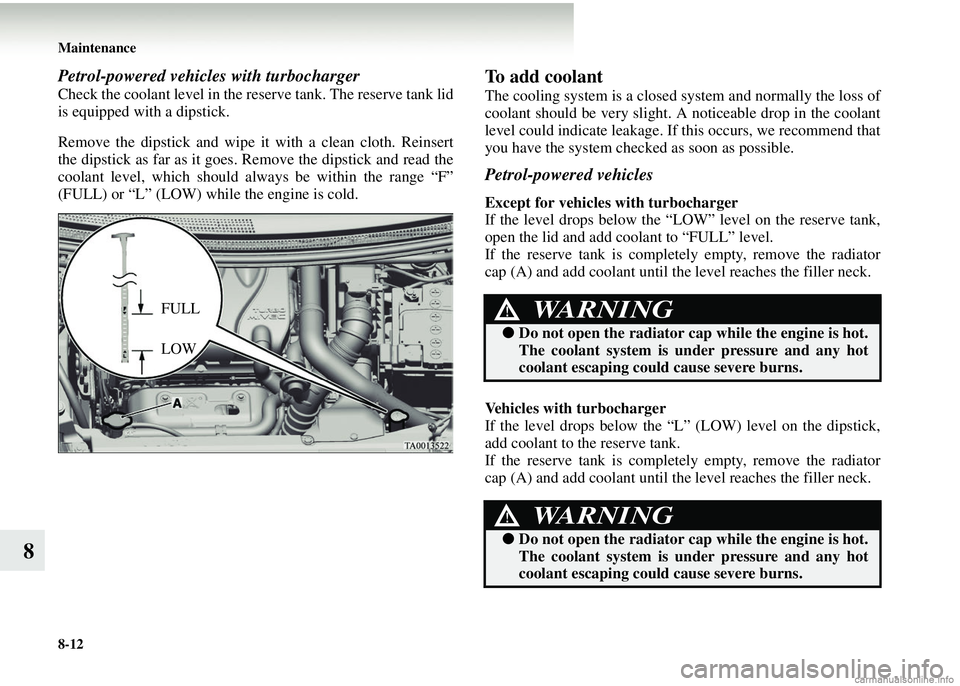
8-12 Maintenance
8
Petrol-powered vehicles with turbocharger
Check the coolant level in the reserve tank. The reserve tank lid
is equipped with a dipstick.
Remove the dipstick and wipe it with a clean cloth. Reinsert
the dipstick as far as it goes. Remove the dipstick and read the
coolant level, which should always be within the range “F”
(FULL) or “L” (LOW) while the engine is cold.
To add coolant
The cooling system is a closed system and normally the loss of
coolant should be very slight. A noticeable drop in the coolant
level could indicate leakage. If this occurs, we recommend that
you have the system checked as soon as possible.
Petrol-powered vehicles
Except for vehicles with turbocharger
If the level drops below the “LOW” level on the reserve tank,
open the lid and add coolant to “FULL” level.
If the reserve tank is completely empty, remove the radiator
cap (A) and add coolant until the level reaches the filler neck.
Vehicles with turbocharger
If the level drops below the “L” (LOW) level on the dipstick,
add coolant to the reserve tank.
If the reserve tank is completely empty, remove the radiator
cap (A) and add coolant until the level reaches the filler neck.
FULL
LOWWARNING!
● Do not open the radiator ca p while the engine is hot.
The coolant system is u nder pressure and any hot
coolant escaping coul d cause severe burns.
WARNING!
●Do not open the radiator ca p while the engine is hot.
The coolant system is u nder pressure and any hot
coolant escaping coul d cause severe burns.
Page 355 of 450
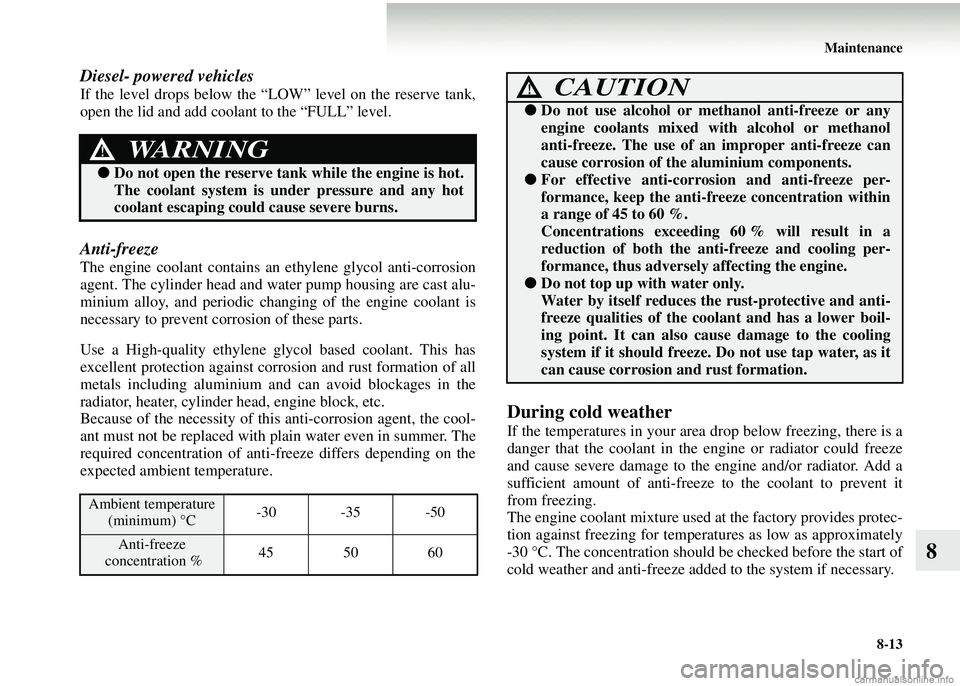
Maintenance8-13
8
Diesel- powered vehicles
If the level drops below the “LOW” level on the reserve tank,
open the lid and add coolant to the “FULL” level.
Anti-freeze
The engine coolant contains an ethylene glycol anti-corrosion
agent. The cylinder head and wa ter pump housing are cast alu-
minium alloy, and periodic changing of the engine coolant is
necessary to prevent corrosion of these parts.
Use a High-quality ethylene glycol based coolant. This has
excellent protection against corros ion and rust formation of all
metals including aluminium and can avoid blockages in the
radiator, heater, cylinder head, engine block, etc.
Because of the necessity of this anti-corrosion agent, the cool-
ant must not be replaced with plain water even in summer. The
required concentration of anti -freeze differs depending on the
expected ambient temperature.
During cold weather
If the temperatures in your ar ea drop below freezing, there is a
danger that the coolant in the engine or radiator could freeze
and cause severe damage to the engine and/or radiator. Add a
sufficient amount of anti-freeze to the coolant to prevent it
from freezing.
The engine coolant mixture used at the factory provides protec-
tion against freezing for temperat ures as low as approximately
-30 °C. The concentration should be checked before the start of
cold weather and anti-freeze added to the system if necessary.
WARNING!
●Do not open the reserve tank while the engine is hot.
The coolant system is under pressure and any hot
coolant escaping coul d cause severe burns.
Ambient temperature
(minimum) °C -30 -35 -50
Anti-freeze
concentration % 45 50 60
CAUTION!
●
Do not use alcohol or me thanol anti-freeze or any
engine coolants mixed with alcohol or methanol
anti-freeze. The use of an improper anti-freeze can
cause corrosion of the aluminium components.
● For effective anti-corro sion and anti-freeze per-
formance, keep the anti -freeze concentration within
a range of 45 to 60 %.
Concentrations exceeding 60 % will result in a
reduction of both the an ti-freeze and cooling per-
formance, thus adversel y affecting the engine.
●Do not top up with water only.
Water by itself reduces th e rust-protective and anti-
freeze qualities of the cool ant and has a lower boil-
ing point. It can also cause damage to the cooling
system if it should freeze. Do not use tap water, as it
can cause corrosion and rust formation.
Page 357 of 450
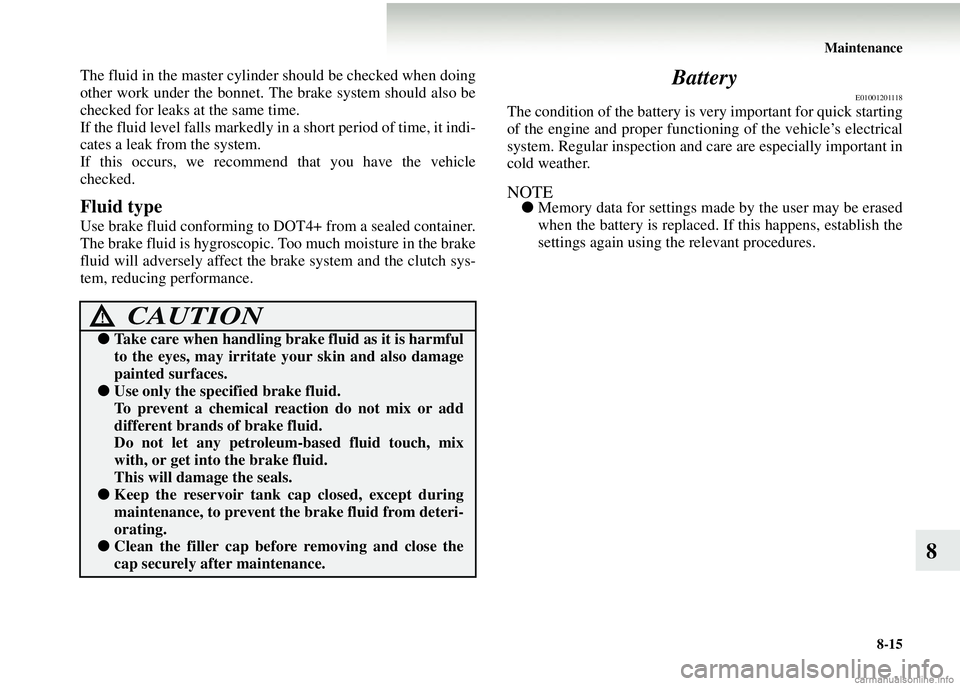
Maintenance8-15
8
The fluid in the master cylinder should be checked when doing
other work under the bonnet. Th e brake system should also be
checked for leaks at the same time.
If the fluid level falls markedly in a short period of time, it indi-
cates a leak from the system.
If this occurs, we recommen d that you have the vehicle
checked.
Fluid type
Use brake fluid conforming to DOT4+ from a sealed container.
The brake fluid is hygroscopic. Too much moisture in the brake
fluid will adversely affect the br ake system and the clutch sys-
tem, reducing performance.
Battery
E01001201118
The condition of the battery is very important for quick starting
of the engine and proper functioning of the vehicle’s electrical
system. Regular inspection and care are especially important in
cold weather.
NOTE● Memory data for settings made by the user may be erased
when the battery is replaced. If this happens, establish the
settings again using the relevant procedures.
CAUTION!
● Take care when handling brake fluid as it is harmful
to the eyes, may irritate your skin and also damage
painted surfaces.
●Use only the speci fied brake fluid.
To prevent a chemical reaction do not mix or add
different brands of brake fluid.
Do not let any petroleum-based fluid touch, mix
with, or get into the brake fluid.
This will damage the seals.
● Keep the reservoir tank cap closed, except during
maintenance, to prevent th e brake fluid from deteri-
orating.
● Clean the filler cap before removing and close the
cap securely after maintenance.
Page 359 of 450
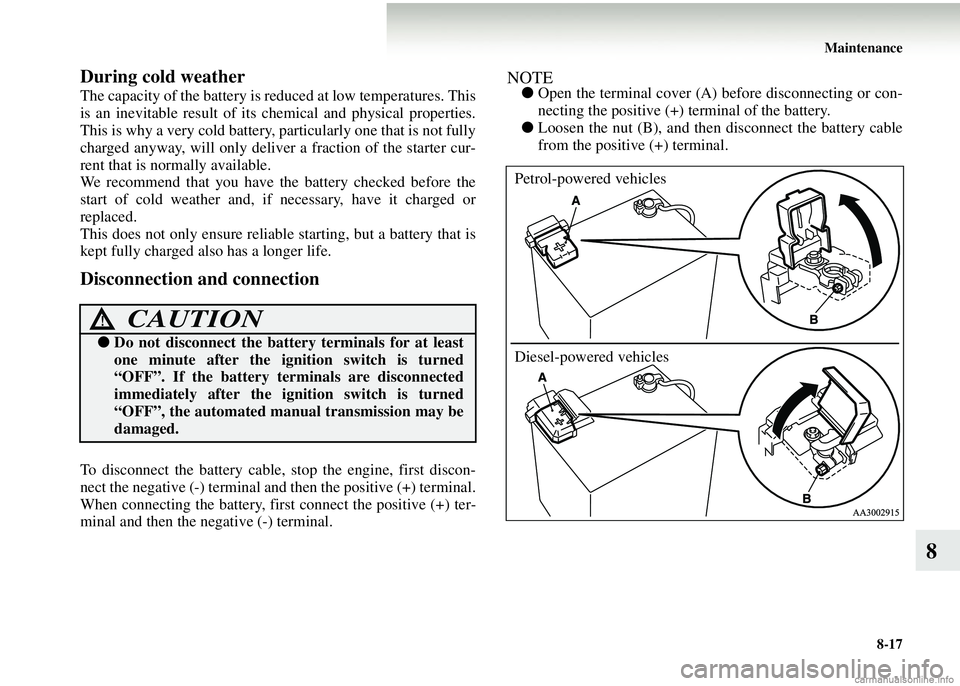
Maintenance8-17
8
During cold weather
The capacity of the battery is re duced at low temperatures. This
is an inevitable result of its ch emical and physical properties.
This is why a very cold battery, particularly one that is not fully
charged anyway, will only delive r a fraction of the starter cur-
rent that is normally available.
We recommend that you have th e battery checked before the
start of cold weather and, if necessary, have it charged or
replaced.
This does not only ensure reliable starting, but a battery that is
kept fully charged also has a longer life.
Disconnection and connection
To disconnect the battery cable, stop the engine, first discon-
nect the negative (-) terminal and then the positive (+) terminal.
When connecting the battery, first connect the positive (+) ter-
minal and then the negative (-) terminal.
NOTE● Open the terminal cover (A) before disconnecting or con-
necting the positive (+) terminal of the battery.
● Loosen the nut (B), and then disconnect the battery cable
from the positive (+) terminal.
CAUTION!
● Do not disconnect the batt ery terminals for at least
one minute after the igni tion switch is turned
“OFF”. If the battery terminals are disconnected
immediately after the igni tion switch is turned
“OFF”, the automated manu al transmission may be
damaged.
Petrol-powered vehicles
Diesel-powered vehicles
Page 370 of 450
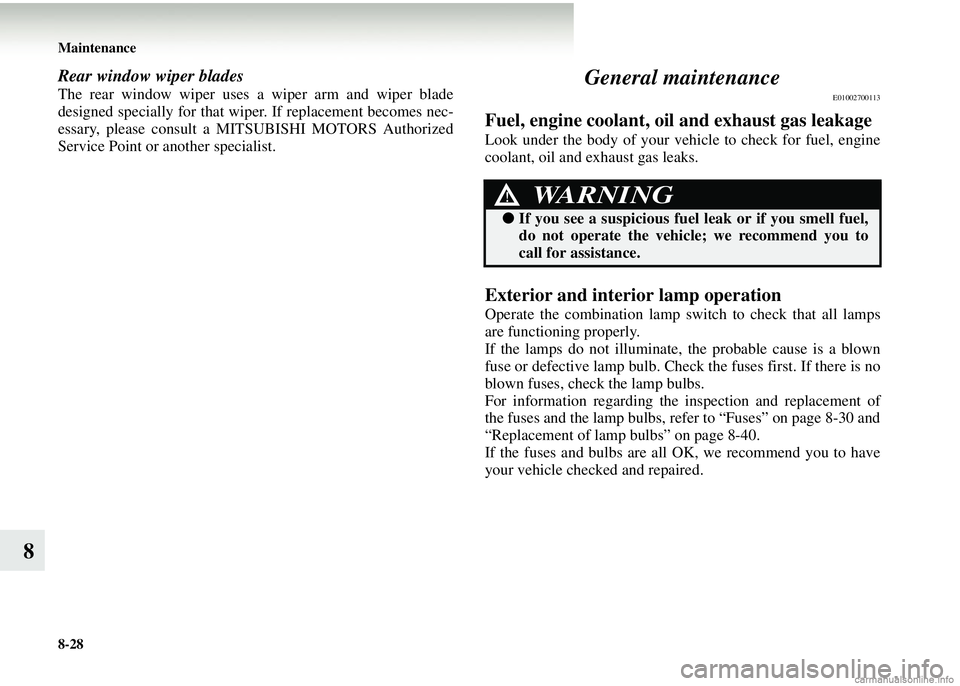
8-28 Maintenance
8
Rear window wiper blades
The rear window wiper uses a wiper arm and wiper blade
designed specially for that wipe r. If replacement becomes nec-
essary, please consult a MITSUBISHI MOTORS Authorized
Service Point or another specialist.General maintenance
E01002700113
Fuel, engine coolant, o il and exhaust gas leakage
Look under the body of your vehicle to check for fuel, engine
coolant, oil and exhaust gas leaks.
Exterior and interior lamp operation
Operate the combination lamp sw itch to check that all lamps
are functioning properly.
If the lamps do not illuminate, the probable cause is a blown
fuse or defective lamp bulb. Check the fuses first. If there is no
blown fuses, check the lamp bulbs.
For information regarding th e inspection and replacement of
the fuses and the lamp bulbs, refer to “Fuses” on page 8-30 and
“Replacement of lamp bu lbs” on page 8-40.
If the fuses and bulbs are all OK, we recommend you to have
your vehicle checked and repaired.
WARNING!
● If you see a suspicious fuel leak or if you smell fuel,
do not operate the vehicle; we recommend you to
call for assistance.